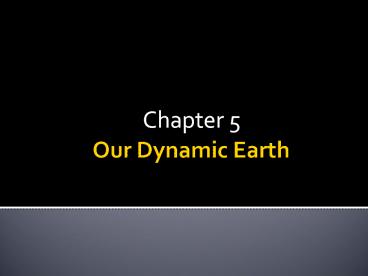Our Dynamic Earth - PowerPoint PPT Presentation
1 / 23
Title:
Our Dynamic Earth
Description:
Waves move like ripples on a pond ... 4_Module 5_Module 6_Module Our Dynamic Earth Lesson 1, ... Volcanoes Volcanoes Building Islands Earthquakes Earthquakes How is ... – PowerPoint PPT presentation
Number of Views:138
Avg rating:3.0/5.0
Title: Our Dynamic Earth
1
Our Dynamic Earth
- Chapter 5
2
Lesson 1, Earths Landforms
- Landform- a physical feature on Earths surface.
3
The Ocean Floor
- Abyssal Plain- wide, flat area of the ocean
floor. - Trenches- deepest parts of the ocean floor.
- Rift Valley- indentation along tops of underwater
mountains.
4
The Earths Layers
- Atmosphere- includes all the gases around Earth.
- Hydrosphere- all of Earths water.
- Crust- rocky layer of Earth.
- Mantle- Earths interior below the crust.
- Inner Core- deep inside Earth made of solid
metals.
5
The Earths Layers
- Diagrams
6
Plate Tectonics
- Geologist- a scientist who examines rocks to find
out about Earths history and structure.
7
Theory of Continental Drift
- Theory that the continents slowly moved to the
position where they are today. - Rock types- are the same in Eastern South America
and western Africa.
8
(No Transcript)
9
How Do Mountains Form?
- Faults- deep cracks in the Earths crust.
Movement along these cracks can form mountains.
10
Mountains
- Folded mountains
- The Himalayan Mountains
11
Mountains
- Fault-block Mountains
- The Sierra Nevada Mountains
12
Volcanoes
- Volcano- an opening in Earths crust.
- Most likely to form at plate boundaries.
13
Volcanoes
- Tend to erupt when one plate is pushed under
another plate. - Rocks in the mantle melt and magma forms in a
chamber. - Pressure in the chamber grows and the magma is
forced upward through cracks. - Magma reaching the Earths surface is called lava.
14
Cinder Cone Volcanoes
- Form when thick lava is thrown into the air and
falls as chunks or cinders.
15
Volcanoes Building Islands
- Hot Spot- a stationary pool of magma below
Earths crust. As the plate moves, new islands
are formed.
16
Earthquakes
- Earthquake- sudden movement of the Earths crust.
- Waves move like ripples on a pond, making the
surface and anything on it move.
17
Earthquakes
- Earthquakes happen along the boundaries of
tectonic plates.
18
How is an Earthquakes Energy Measured?
- Magnitude- a measure of the amount of energy
released by an earthquake. - Richter Scale- measures the magnitude at the
epicenter.
19
How is an Earthquakes Energy Measured?
- Mercalli Scale- measures what people felt and
what happened to objects at a specific location.
20
Tsunamis
- Tsunami- a huge wave, usually occurring after an
underwater earthquake.
21
Weathering
- Chemical weathering- acid rain can wear away at
stone and metals.
22
Weathering
- Erosion- weathered rock is moved from one place
to another place.
23
Depostion
- As water is running faster, it can wash away soil
and rock. - When the water slows, the water will drop the
material in another place.































